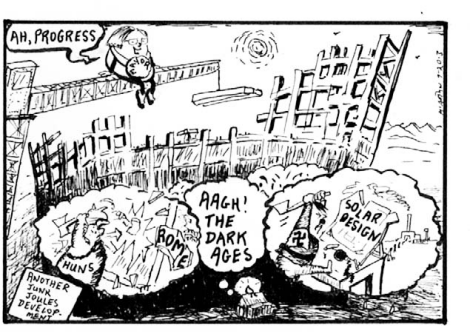
I cannot believe it. 2500 years ago ancient Greeks decreed you can not build out another manís sun. Justinian Code in the 6th century protected each manís right to the sun. I ring my local city council and confirm it. In 21st Century New Zealand a citizen is effectively free to destroy their neighbourís access to solar energy. Solar energy has no real value in our codes.

JOURNEY index Look back to 2 Journey on to 4
John Perlin*, co-author [with Ken Butti] of A Golden Thread - 2500 Years of Solar Architecture and Technology, provides a short summary of the evolution of passive solar design on the Calfornia Solar Centre website. Passive Solar refers to an approach to heating and cooling homes through simple devices and architectural design, as opposed to mechanically operated heating and cooling systems.
These quotes are from the website:
Re. Greece
"During
the fifth century BC., the Greeks faced severe fuel shortages. Fortunately, an
alternative source of energy was available - the sun. Archaeological evidence
shows that a standard house plan evolved during the fifth century so that every
house, whether rural or urban, could make maximum use of the sun's warm rays
during winter. Those living in ancient Greece confirm what archaeologists have
found. Aristotle noted, builders made sure to shelter the north side of the
house to keep out the cold winter winds. And Socrates, who lived in a
solar-heated house, observed, "In houses that look toward the south, the
sun penetrates the portico in winter" which keeps the house heated in
winter. The great playwright Aeschylus went so far as to assert that only
primitives and barbarians "lacked knowledge of houses turned to face the
winter sun, dwelling beneath the ground like swarming ants in sunless
caves."
The ancient Greeks planned whole cities in Greece and Asia Minor such as Priene, shown in the illustration, to allow every homeowner access to sunlight during winter to warm their homes. By running the streets in a checkerboard pattern running east-west and north-south pattern every home could face south, permitting the winter sun to flow into the house throughout the day."
Re. Rome
"Fuel
consumption in ancient Rome was even more profligate than in Classical Greece.
In architecture, the Romans remedied the problem in the same fashion as did the
Greeks. Vitruvius, the preeminent Roman architectural writer of the 1st century
BC., advised builders in the Italian peninsula, "Buildings should be
thoroughly shut in rather than exposed toward the north, and the main portion
should face the warmer south side." Varro, a contemporary of Vitruvius,
verified that most houses of at least the Roman upper class followed Vitruvius'
advice, stating, "What men of our day aim at is to have their winter rooms
face the falling sun [southwest]." The Romans improved on Greek solar
architecture by covering south-facing windows with clear materials such as mica
or glass. They also passed sun-right laws that forbade other builders from
blocking a solar-designed structure's access to the winter sun.
The ancient Romans not only used window coverings to hold in solar heat for their homes but also relied on such solar heat traps for horticulture so that plants would mature quicker, produce fruits and vegetables out of season, and allow for the cultivation at home of exotic plants from hotter climates. With the fall of the Roman Empire, so to came the collapse of glass for either buildings or greenhouses. Only with the revival of trade during the 16th century came renewed interest in growing in solar-heated greenhouses exotics brought back from the newly-discovered lands of the East Indies and the Americas. Trade also created expendable incomes that allowed the freedom to take up such genteel pursuits as horticulture once more."
Chapter Seven - The House of Life- Into The Dark Ages with the Dark Stuff.
Bonus Joules and the Knowledge Economy: All images on this site are copyright.